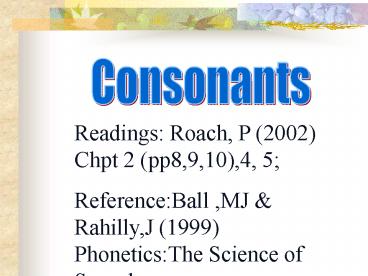Consonants - PowerPoint PPT Presentation
1 / 12
Title:
Consonants
Description:
Readings: Roach, P (2002) Chpt 2 (pp8,9,10),4, 5; ... Recorded exercises. Pg.218, Audio Unit 4, Ex 1, 2,3,4,5. Next week, read Chapters 6,7 of Roach ... – PowerPoint PPT presentation
Number of Views:346
Avg rating:3.0/5.0
Title: Consonants
1
Consonants
Readings Roach, P (2002) Chpt 2 (pp8,9,10),4, 5
ReferenceBall ,MJ Rahilly,J (1999)
PhoneticsThe Science of Speech
2
Vocal Tract - Anatomy Physiology
- Setting a column of air in motion
- Larynx, Lungs
- Pharynx
- Oral cavity, nasal cavity (resonating
- chambersloudness sd. quality)
- Trachea
- (Transparency Vocal Tract)
3
Inside the larynx some key playersarytenoid
cartilages , vocal folds / vocal cordsGlottis
opening between the vocal folds
(Transparency states of the glottis)
4
Describing consonants I
- Range of parameters
- Airstream mechanism
- Direction of airflow
- Phonation type and location
- State of the velum
- Centrality vs laterality
5
Describing consonants II
f. Force of articulation g. Prolongability h.
Place of articulation i. Manner of articulation
z-a pulmonic egressive full glottal voiced oral
central lenis prolongable alveolar fricative.
6
Describing consonants III
- Three-term labels
- Phonation
- Place of articulation
- Manner of articulation
- Eg. ? can be described as a voiced alveolar
fricative (three-term labels)
7
Phonation
Voiceless vs voiced Voiceless- no vibration,
glottis open(60-90) Voiced vibration of the
vocal folds/cords Fortis vs Lenis Fortis-
stronger force of articulation, longer
duration Lenis- weaker force of articulation
8
Place of articulation
- Active or passive articulator
- Roof of the mouth
- Labial, Dental, Alveolar, Palatal,Velar(Soft
palate), Uvular, Pharyngeal, Glottal
- Tongue surface
- Tip, blade, front back dorsum, root, epiglottis
Transparency (Places of articulation)
9
Manner of articulation
How individual sounds are made. Based on the size
of the air passage (stricture) during the
production of sound (Transparency IPA chart)
10
English Plosives I
- Plosive Consonants
- 4 phases of production
- closing phase- articulators move to form
stricture - compression phase- compressed air stopped from
escaping - release phase- articulators move to allow air to
escape - post-release phase after release phase (eg.
aspiration p,t,k)
11
English Plosives II
English plosives - p, t, k, b, d, g
p, b bilabial t,d alveolar, tongue blade
against alveolar ridge k,g velar, back of tongue
against this area
3 term labels??(phonation,place,manner)
12
The End
Tutorial (Roach) Pg. 37, No. 2 Recorded
exercises Pg.218, Audio Unit 4, Ex 1, 2,3,4,5
Next week, read Chapters 6,7 of Roach































